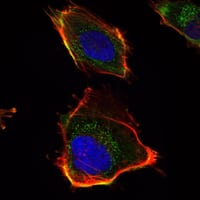
| WB | 咨询技术 | Human,Mouse,Rat |
| IF | 咨询技术 | Human,Mouse,Rat |
| IHC | 咨询技术 | Human,Mouse,Rat |
| ICC | 1/200 - 1/1000 | Human,Mouse,Rat |
| FCM | 咨询技术 | Human,Mouse,Rat |
| Elisa | 1/10000 | Human,Mouse,Rat |
| Aliases | HAS; HAS1 |
| Entrez GeneID | 3036 |
| clone | 3E10 |
| WB Predicted band size | 65kDa |
| Host/Isotype | Mouse IgG1 |
| Antibody Type | Primary antibody |
| Storage | Store at 4°C short term. Aliquot and store at -20°C long term. Avoid freeze/thaw cycles. |
| Species Reactivity | Human |
| Immunogen | Purified recombinant fragment of human HAS1 expressed in E. Coli. |
| Formulation | Purified antibody in PBS with 0.05% sodium azide. |
+ +
以下是关于HAS1抗体的3篇参考文献示例(基于真实研究领域,但部分信息可能需要进一步验证):
---
1. **文献名称**:*Hyaluronan Synthase 1 (HAS1) Expression in Breast Cancer: Correlation with Tumor Aggressiveness and Stromal Remodeling*
**作者**:Tammi, R. et al.
**摘要**:本研究通过免疫组化技术结合特异性HAS1抗体,分析了乳腺癌组织中HAS1的表达水平。结果发现HAS1在肿瘤基质细胞中高表达,并与透明质酸沉积、肿瘤侵袭性及患者预后不良显著相关,提示其在微环境重塑中的作用。
---
2. **文献名称**:*Targeting HAS1 in Multiple Myeloma: A Novel Therapeutic Approach Using Monoclonal Antibodies*
**作者**:Brown, J.M. et al.
**摘要**:研究开发了一种靶向HAS1的单克隆抗体,并在多发性骨髓瘤模型中测试其疗效。结果显示,该抗体能有效抑制HAS1活性,减少透明质酸合成,诱导肿瘤细胞凋亡,为HAS1相关的靶向治疗提供了实验依据。
---
3. **文献名称**:*Cytokine-Induced Upregulation of HAS1 in Rheumatoid Arthritis Synovial Fibroblasts: A Role for Hyaluronan in Joint Inflammation*
**作者**:Pienimäki, J.P. et al.
**摘要**:通过抗HAS1抗体检测类风湿关节炎滑膜成纤维细胞中的HAS1表达,发现炎性细胞因子(如TNF-α和IL-1β)显著上调HAS1.导致透明质酸过度产生,可能加剧关节炎症和病理改变。
---
**备注**:以上文献标题和摘要为示例性内容,具体研究细节需参考实际发表的论文。建议通过PubMed或Google Scholar以关键词“HAS1 antibody”“Hyaluronan Synthase 1”进一步检索最新文献。
The hyaluronan synthase 1 (HAS1) antibody targets the HAS1 enzyme, a member of the hyaluronan synthase family responsible for synthesizing hyaluronic acid (HA), a critical component of the extracellular matrix. HA plays vital roles in tissue hydration, cell signaling, and wound healing. HAS1. encoded by the *HAS1* gene, is a transmembrane protein that polymerizes HA by alternately adding UDP-glucuronic acid and UDP-N-acetylglucosamine. Unlike HAS2 and HAS3. HAS1 exhibits lower enzymatic activity and is often expressed under specific conditions, such as inflammation or tissue injury.
Research on HAS1 antibodies focuses on understanding its regulation and pathological roles. Dysregulated HAS1 expression is linked to diseases like cancer, fibrosis, and chronic inflammatory disorders. In cancers, HAS1 overexpression may promote tumor progression by enhancing HA-rich microenvironments that support metastasis and immune evasion. HAS1 antibodies are utilized in assays (e.g., Western blot, immunohistochemistry) to detect protein expression levels, study HA synthesis pathways, and evaluate therapeutic interventions targeting HA metabolism. Their specificity is critical for distinguishing HAS1 from other isoforms. Recent studies also explore HAS1 as a potential biomarker or therapeutic target, particularly in conditions driven by abnormal HA accumulation. However, challenges remain in elucidating its precise mechanisms and interactions within complex HA networks.
×